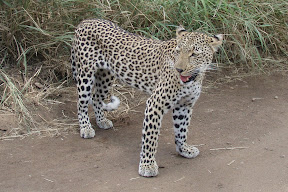A Moment in Africa
South Africa hardly resembles the traditional images that come to mind when you think of Africa… the rolling savannahs and desserts, the tropical rain forest areas. In fact, the majority of the places I have visited thus far remind me more of home then of what I would envision when thinking of Africa. My site is nestled up against a mountain, which looks very much like New Mexico. Many of the open areas resemble the deserts of California. And as you climb into the mountains, such as the Drakensberg Range, you see rock formations that resemble Arizona and mountain lakes that bring back memories of Colorado.
Yet, every once and a while, there will be a view or a moment that resembles some traditional notion of what we expected South Africa to be like. Whether it is a stunning sunrise or the breathtaking moment when a herd of elephants crosses the road on all sides of our car. And when with other volunteers, we will pull out our cameras and comment that it truly looks like Africa. So I wanted to share one of those moments, when it was unequivocally a moment in Africa.
Three close friends and I were visiting Kruger National Park. Just to give a little background, Kruger is one of the largest game reserves in the world. It is about the size of Wales (and is now growing as fences between it and neighboring private reserves and other international reserves are being torn down). It is home to a vast variety of animal and plant life, scattered through out three major eco-zones and many sub eco-zones. Spending a day driving around Kruger, one will often pass from zone to zone and suddenly see a very different environment outside the window. Most of our time is spent driving around, looking for animals. But there are also well maintained rest camps, where you can stop for food or to stay the night.
So upon spotting a turn off for a baobab tree, we decided to go off and explore. The trees are stunning in size, and in formation, with extremely thick trunks (usually about 23ft wide). The trunks are used to store water (up to 32,000 gallons), allowing it to survive through the periods of intense drought. The one in Kruger did not appear to be in the greatest health, but gathering at the base, we were able to appreciate the magnificent size and stature of the tree.
We continued on the curvy dirt road, hoping to make our way back to the main paved road. Coming around a corner, we saw a feline approaching us. And three cars in the opposite direction crowding in to try and get a view of the animal who was walking straight towards our car. We had the good fortune to be the only car coming from our direction, so we had a stunning view. It was a mother leopard, and shortly after, we saw her little cub following behind in a shy manner. Although she seemed quite unfazed by the gathering cars, the cub would run off into the tall grass on the side of the road to hide every so often. The mother would stop and look back impatiently, waiting as the cub got its courage together to walk a little further along the road. You could even here it cry out – little meows emanating from the deep grass, where it hid. The pair walked right by our car, reaching distance from the window and continued on down the road. Simply said, we were awe struck. It had a beautiful body, dotted by rosettes of black spots on a whitish golden background. Its movements were quiet and full of grace. And interestingly, since then, I have learned that it is second most effective predator in Kruger (only outdone by the African Hunting Dog).
The leopard spotting completed the Big Five for us (well, three of us). We’d already seen lions, elephants, African Buffalo and a few rhinoceroses. And of course, we’d also seen giraffes, hippos, baboons, zebras, all sorts of gazelles and amazing birds of all varieties. While wandering the roads of Kruger, the amazing sights and beautiful landscape offer a strong reminder of the fact that we are living in Africa – in some ways, it is not so foreign feeling as we often think, but at the same time, there are some special, beautiful moments that are unique to Africa.
Photos (taken by my friends Abby and Megan)
Labels: travel


